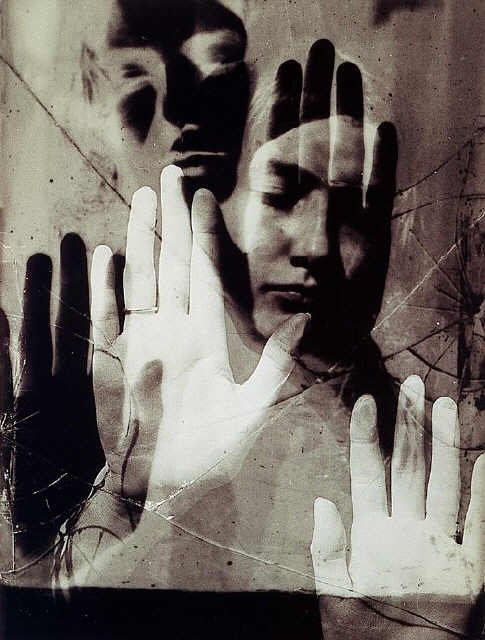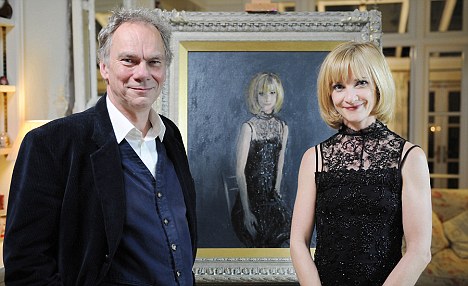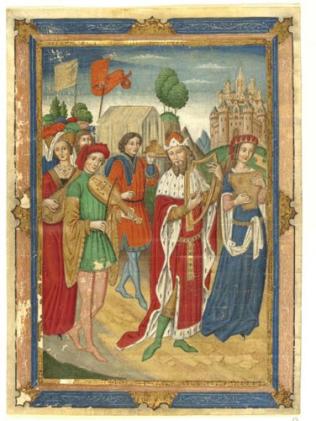On 12 Jan, 2011 With
Art Terms: Grisaille Grisaille is a term for painting executed entirely in monochrome or near-monochrome, usually in shades of grey. It is particularly used in large decorative schemes in imitation of sculpture. Many grisailles in fact include a slightly wider colour range, like the Andrea del Sarto fresco illustrated. Paintings executed in brown are sometimes referred to by the more specific term brunaille, and paintings executed in green are sometimes called verdaille. A grisaille may be executed for its own sake, as underpainting for an oil painting (in preparation for glazing layers of colour over it), or as a model for an engraver to work from. “Rubens and his school sometimes use monochrome techniques in sketching compositions for engravers.” Full…
Read More
On 11 Jan, 2011 With
In 1943 Picasso (age 62) then kept company with young art student Françoise Gilot (born in 1921). Their two children were Claude (1947) and Paloma (1949) who was named for the dove of peace that Picasso painted in support of the peace movement post World War II. Gilot, frustrated with Picasso’s relationships with other woman and his abusive nature left him in 1953. Gilot’s book “Life with Picasso” was published 11 years after their separation. In 1970 she married American physician-researcher Jonas Salk (who later died in 1995).
Read More
On 7 Jan, 2011 With
Why “kitsch”? The painters invited to exhibit at The Kitsch Biennale 2010 in Venice have been chosen from their ability to create life on canvas – an idea deeply rooted in European Humanism that presupposes insight into anatomy and human psychology, a mind for pathos and a sense for the archetypical narrative. Yet, these values are rootless in contemporary art, which generally disregards skill and aims to reflect the time. They were not included in the modern concept of art (originally “fine art”), which was born about 250 years ago. Rejecting handcraft and sincerity, art represents a break with the values of the Renaissance and Baroque and not a continuation of them. Because of this situation an alternative to art…
Read More
On 4 Jan, 2011 With
Dora Maar and Picasso (1936-1944) In 1936 54-year old Picasso met Yugoslavian Dora Maar (1907 -1997), the photographer who documented Picasso’s painting of Guernica, the 1937 painting of Picasso’s depiction of the German’s having bombed the Basque city of Guernica, Spain during the Spanish Civil War. She became Picasso’s constant companion and lover from 1936 through April, 1944. Maar went back to painting and exhibited in Paris soon after Picasso left her for Françoise. Picasso referred to Dora as his “private muse”. In later years she became a recluse, dying poor and alone.
Read More
On 3 Jan, 2011 With
The true story of the downfall of an amateur artist who pulled off the world’s most audacious art fraud By LANEY SALISBURY The experts gathered at London’s Tate gallery watched in appreciative silence as two white-gloved curators carried the museum’s latest acquisitions into its boardroom. Paintings of birds by a highly regarded but little-known Fifties French artist named Roger Bissiere, they had been donated by Professor John Drewe, a distinguished scientist and businessman. On that April afternoon in 1990, everything about Drewe suggested that he was a gentleman of style and substance, from his pencil-thin moustache to his expensive suit. His bequests, however, were not all they seemed. Far from being the modern masterpieces Drewe claimed, they had, in fact, been…
Read More
On 30 Dec, 2010 With
The Spanish Forger is the name given to an unidentified individual who, in the late 19th to early 20th century, created a large number of forgeries of medieval miniatures. The Spanish Forger’s works were painted on vellum or parchment leaves of genuine medieval books, using either blank margins or scraping off the original writing. He also “completed” unfinished miniatures or added missing miniatures in medieval choir books. His works fooled many experts and collectors and appear today in the collections of many museums and libraries. Over 200 forgeries have been identified. Although he was originally thought to be Spanish, it is now believed he may have been French, working in Paris. A number of his forged miniatures have been identified as copied, with modifications,…
Read More
On 28 Dec, 2010 With
The 21-year-old ‘sex kitten’ holds her own against the old predator, Picasso, during a visit to his studio at Vallauris, near Cannes, during the film festival in 1956 When the first Daguerreotype photograph was taken in the 1830s, a French artist sonorously prophesied: “From this day, painting is dead.” It took Picasso to prove him wrong, by demonstrating the limits of photographic vision. The camera is restricted to surfaces; painting, if it is as aggressive and inquisitorial as Picasso’s, can torment and transform the world of appearances, violently metamorphosing matter. “Reality must be torn apart,” Picasso told his lover, Françoise Gilot. People, especially women, had to undergo the same painful fate. In the gutted art nouveau salon of his villa, the…
Read More
On 27 Dec, 2010 With
This original etching, Femme assise au Chapeau et Femme debout drapée, 29.1.1934 (Seated woman with a hat and standing woman draped) is one of 100 images from the famous Vollard Suite. Picasso created the etching plate that was used to print this etching on January 29, 1934. In January, 1934 Picasso stayed at his Paris studio, entering a very productive period, continuing to be inspired by Marie-Thérèse. He does not introduce her to friends or publicly acknowledge her as his mistress. In this same month artist Dali and Gala are married in Paris. This is the last full year that Olga and Picasso stay married, separating in June, 1935, but never divorcing as doing so would have required Picasso to…
Read More
On 26 Dec, 2010 With
A Picasso painting of one of his mistresses today sold for £70.3million ($106.5million) — a world record price for any artwork sold at auction. The 1932 Nude, Green Leaves And Bust, which had a pre-sale estimate of £46 million-£59million, was sold to an undisclosed telephone bidder at a Christie’s impressionist and modern art auction in New York. The sale — equivalent to £21,537 for each square inch of the artwork — surpassed the £65million paid for Giacometti’s L’Homme Qui Marche at Sotheby’s in February. The previous highest price for a Picasso was $104.2 million for Boy With A Pipe (The Young Apprentice) sold at Sotheby’s in New York in 2004. The painting, a large-scale depiction of Pablo Picasso’s mistress Marie-Thérèse…
Read More
On 25 Dec, 2010 With
Kenneth Andrew Walton (born November 23, 1967) is an American software developer and author of the memoir Fake: Forgery, Lies, & eBay, which details his time spent selling forged art on the online auction site eBay. He currently lives with his wife in San Francisco, California. In 1999 and 2000 Walton was working as an attorney in Sacramento, California, and selling art on eBay, using more than 40 online aliases to drive up bidding on hundreds of his paintings. In May 2000 he posted an auction on eBay for an oil painting that attracted a closing bid of $135,805 and which bidders speculated might be a work by Richard Diebenkorn due to its resemblance to the artist’s work, the existence of the monogram “RD52” on the…
Read More




